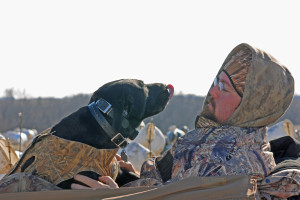 Before we get started, let’s just put this out there…if you are buying an electronic collar to punish your dog, stop right now! The collar should only be used to enforce behavior already learned, not train or punish an animal. Duck hunting dogs are not stupid and they will figure out how to beat you at this game if you do not play by the right rules.
Before we get started, let’s just put this out there…if you are buying an electronic collar to punish your dog, stop right now! The collar should only be used to enforce behavior already learned, not train or punish an animal. Duck hunting dogs are not stupid and they will figure out how to beat you at this game if you do not play by the right rules.
Dogs have three natural reactions to electronic collar stimulation: run, freeze, or sulk. You do not want any of these. What you want is for your duck hunting dog to perform a task. In addition, you do not want the dog to associate the collar with a negative experience, so this will take some pre training on your part.
Before you use the electronic collar…
You need to get your dog used to A collar. Associate the collar with going out, playing, taking a walk, things the dog loves to do. Show him the collar, put it on, and then do one of these activities. By doing this, you are showing the dog that the collar actually leads to something he wants to do and looks forward to putting the collar on instead of running and hiding when he sees it.
Once the dog is familiar with the collar, the electronic collar can be used to condition the dog, even for duck hunting behavior. Let’s take a look at a basic command to explain how it should be used properly.
You are having a problem with your dog listening to your “Kennel” command (your word for him to get into his crate or cage). Electronic collars “stimulate” for a few seconds. If you give the command and the dog runs, then you stimulate, right? Wrong! By doing this, you play right into the dogs natural three reactions. The dog runs and the collar stimulates him for ten seconds. He will do one of three things:
- Continue to run until the collar’s safety feature kicks in and it automatically goes off. At this point, he knows if he just takes it for a few seconds, it will stop and he can keep doing what he wants to do.
- He will freeze, which is just as bad as running because he is still not listening to the command. In this case, he also realizes that eventually the collar goes off and he can go back to doing what he wants to do.
- He starts pouting. He does not understand why he is being punished, he just knows that this thing is stimulating him and he does not like it at all.
Instead of taking the discipline approach, take the reinforcement approach.
- Power up the collar on the lowest setting and increase the setting until you see the collar gets the dogs attention. For some dogs, even big dogs, it might be a 2. For others, it may take until 5 or 6 before they notice it is even there.
- Now, prior to actually giving a command, stimulate the dog. Now give the command. In this case, “Kennel”. Once the dog is headed to the cage or kennel and is within about five feet, turn the collar off. Now, the dog will realize that if he follows your command, the stimulation stops. If at any time the dog decides to stray away from the path of the cage, engage the collar until he gets back on track.
- After repeating this training exercise, you can now back off the collar completely and give the command. If the dog immediately heads to his kennel, the collar is never engaged. However, if he strays, engage the collar again. Eventually, the dog realizes that as long as he does what you tell him to do immediately, the stimulation never occurs.
This same technique can be used for duck hunting field commands until the dog perfects them. If done this way, the collar is not discipline but reinforcement of a command. He quickly learns that as long I listen and perform the command, nothing happens except for a reward or a good hard pet from his master.






